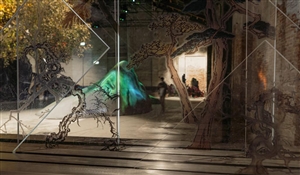Director of "documenta 15" Announced Resignation
31 Jul 2022Hosting numerous art groups since June 18, 2022, in Kassel, Germany, documenta 15 has provoked considerable sociopolitical debates. One of the most controversial issues of the event was a work by an Indonesian group called "Taring Padi" which was accused of Antisemitism. Reactions were severe and direct and caused governments, in addition to people, to respond. Taring Padi agreed to cover the contentious painting under a black fabric and announced an apology that explained the artwork's background and approach.
On Saturday, July 16, documenta's director Sabine Schormann announced her resignation, which was approved immediately. Documenta seems to be the murderer of its directors. Its former director Annette Kulenkampff was dismissed because of her imprudent decisions about the event's costs. Schormann's resignation was a response to a series of internal protests. German artist Hito Steyerl removed her works from the show since she held herself responsible for partnership in the Antisemitism issue. She believed that she might be responsible if her work convinced even one person to come to the show and facilitate Antisemitism.
Germany's culture minister, however, has posed more serious questions; she is worried that a selective mechanism may be operating behind the scenes. How did the work enter documenta in the first place? How sensitive is the regulatory process about social and political positions and the recognition of discrimination against minorities and the subaltern? And even more important, how far can we put social borders in art?
The historical experience of art in the US shows us that a part of art bases, at least those displayed in public spaces, are meaningful in relation to society. The controversy caused by David K. Nelson's painting called "Mirth & Grith" indicates that art cannot be separated from social subjects. Nelson, a student at the Art Institute of Chicago, depicted Chicago's popular black mayor Harold Washington wearing women's underwear. The painting was confiscated shortly after its exhibition. It also led to a civil petition, a legal amendment, and a racial crisis in the US. Many considered the painting not only racist but also sexist. Others regarded the confiscation of the painting as a violation of the freedom of speech principle. Nelson confirmed his intention of iconoclasm and admitted that his expression style throughout his artistic career was aimed at desecrating figures by caricaturing his subjects. Nevertheless, the challenge of limiting the artist within borders has kept the art world busy. Each time it appears in a new form; sometimes in the form of a private exhibition in Chicago and sometimes in a public show in Kassel.
Cover and slider image:
- www. newsrnd.com






